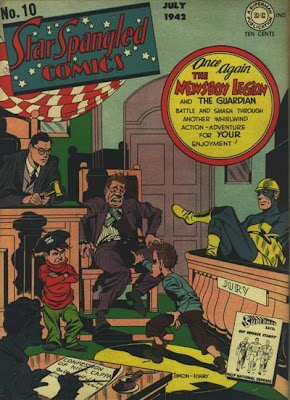Happy Valentine’s Day
 We’re of two minds on this particular occasion, the greeting card holiday known as Valentine’s Day. On the one hand, we feel that we should recognize all of the people out there who will find time today to recognize their love for one another. After all, there’s something to that, we suppose. So, for them, we feature the comic book cover above, that of Marvel Valentine Special #1, published back in the halcyon days of 1997. However, we recognize that the super majority of our readership here is comprised of lawyers, all of whom are extraordinarily cynical by nature. Surely, they are unappreciative of holidays premised upon sincere and genuine human emotions. So, for them, we include the cover below, that of Forbidden Worlds #24, published back in 1953. That one may be a bit more their speed, particularly the litigators. Oh, well.
We’re of two minds on this particular occasion, the greeting card holiday known as Valentine’s Day. On the one hand, we feel that we should recognize all of the people out there who will find time today to recognize their love for one another. After all, there’s something to that, we suppose. So, for them, we feature the comic book cover above, that of Marvel Valentine Special #1, published back in the halcyon days of 1997. However, we recognize that the super majority of our readership here is comprised of lawyers, all of whom are extraordinarily cynical by nature. Surely, they are unappreciative of holidays premised upon sincere and genuine human emotions. So, for them, we include the cover below, that of Forbidden Worlds #24, published back in 1953. That one may be a bit more their speed, particularly the litigators. Oh, well.
All kidding aside, we wish our readers a happy Valentine’s Day today.
Friday Links
- The comic book cover above is that of Star Spangled Comics #10, published way back in 1942. Depicted are The Guardian, sitting a bit too casually in the jury box, and members of the Newsboy Legion, who appear to be conducting a criminal prosecution of sorts. Meanwhile, someone at counsel’s table seems to be drafting the confession of Nick Cappa, the apparent villain of the story, although it’s unclear from the cover whether Cappa is the defendant standing trial. The presiding judge, who is apparently rather lenient on courtroom decorum, looks eerily like Clark Kent, doesn’t he?
- We just realized that this month marks the twentieth anniversary of the publication of John Grisham’s novel, The Firm, which according to Wikipedia, was first published on February 1, 1991. The popular film based on the novel, directed by the late, great Sydney Pollack and starring Tom Cruise, was released two years later in June of 1993.
- RockAAA.com, not an insurance website, asks “Is your download collection insured?” Good question. What happens if you lose both your desktop computer and any external hard drive back up due to some type of accident? We here would be crestfallen. That article, published last November, just recently came to our attention, and notes that most insurance policies in the United Kingdom do not cover downloaded media.
- The Faculty Lounge has a brief post – with links to candidate bios – regarding the five finalists for the dean position at the University of South Carolina law school.
- Alan H. Crede at the Boston Personal Injury Lawyer Blog authors this post entitled “CPSC May Mandate Flesh Detection in Table Saws: Is It a Good Idea?” An issue to monitor, that.
- Our own Jim Dedman takes a break for law blogging to review the new album by David Lowery, the former frontman of such bands as Cracker and Camper Van Beethoven. See his thoughts here at the Dead Journalist blog, a music site out of Atlanta.
Florida Court: Members of Decertified Tobacco Class Action May Use Factual Findings in Individual Cases
RJR primarily contends that the trial court gave the findings approved in Engle overly broad preclusive effect and thus relieved the plaintiff .
. . of her burden to prove legal causation on her negligence and strict
liability claims. RJR also asserts [Plaintiff] failed to prove the reliance
element of her fraudulent concealment claim, and that the punitive damage award
is excessive and unconstitutional.
False Name Results in Dismissal of Complaint
On May 12, 2006, plaintiff was injured while working with a punch press. Components of the machine were manufactured by defendants, and on May 9, 2008, plaintiff filed a product-liability complaint against defendants in the circuit court of Cook County. The initial complaint identified plaintiff as “Juan Ortiz,” and it did not indicate whether he had ever been known by any other name. Plaintiff filed his first amended complaint on November 4, 2008, naming additional defendants that had been identified during discovery. The first amended complaint also named “Juan Ortiz” as the sole plaintiff.
During written discovery, plaintiff received at least three sets of interrogatories from various defendants. Among other information, each set of interrogatories asked plaintiff to disclose personal identification information, including his name, work history, and social security number. Plaintiff answered the interrogatories on February 25, 2009, identifying himself as “Juan Ortiz.” As required by section 1-109 of the Code of Civil Procedure . . . plaintiff signed and verified each interrogatory with the signature “Juan Ortiz.”
Defendants deposed plaintiff on May 19, 2009. When defendants asked plaintiff to state his full name, however, plaintiff responded that his name was Rogasciano Santiago, not Juan Ortiz. This was the first time during the course of litigation that plaintiff had used this name, and defendants had not previously been aware that plaintiff’s true name was not Juan Ortiz. The record does not disclose whether plaintiff’s attorney was aware of plaintiff’s true name.
Shoes Offering Easy "Workout" are New Class Action Targets
Drugmaker’s Decision to Halt Production of Drug Threatens U.S. Death Penalty System
Not too long ago, The Wall Street Journal Law Blog reported that drugmaker Hospira, Inc., based in Lake Forest, Illinois, will permanently cease production of sodium thiopental, an anesthetic that is a key component for the lethal injection drug combinations used in capital punishment. Although states can use a different anesthetic in place of sodium thiopental, such a switch likely would have to be approved by courts and potentially state legislatures.
According to an article in The New York Times, Hospira had planned to resume production of the drug this winter at its plant in Italy, as it does not have any domestic facilities capable of producing the anesthetic. The Italian parliament, however, issued an order prohibiting exportation of the drug if it might be used to perform lethal injections. Hospira issued a statement on January 21, 2011, in which it noted the difficulty of “control[ling] the product all the way to the ultimate end user” to ensure it was not used for capital punishment. Given the issues surrounding the product and the challenges associated with bringing the drug back to the market, Hospira decided to “exit the market.”
Last year, a temporary halt in production delayed scheduled executions in California and Oklahoma. As a result of the shortage, pentobarbital, a drug used to euthanize animals, was reportedly approved for use in capital punishment in Oklahoma when the state sought court clearance to use the drug as a substitute. The New York Times reports that the process of approval in many states may take much longer than that provided for in Oklahoma. Specifically, it quotes the executive director of the Death Penalty Information Center, who notes that many states will require formal proposes, public comment, and challenges in court, which is a process that can take months to complete. It is expected, in light of Hospira’s recent statement, that most states will now follow Oklahoma’s lead in seeking similar approvals of the substitute drug.
The news of Hospira’s decision has reignited debates online about the merits of capital punishment. (See here and here, for example). Hospira’s announcement most certainly will cause states throughout the country to scramble for approval of a new drug combination.
Friday Links
- Believe it or not, but the Marvel Comics character She-Hulk is an attorney. Above, you’ll see the cover of The Sensational She-Hulk #59, published not so long ago in 1994, during which She-Hulk, clad in her courtroom attire, asks the court for a “short recess” so that she can dispose of the host of super villains who have appeared. (One wonders how they all bypassed the security at the courthouse entrance). Whatever the case, we suspect the request was granted by the trial court judge. She-Hulk’s Wikipedia entry describes her as a “highly skilled lawyer” who has “served as legal counsel to various superheroes on numerous occasions.” She apparently practices at the fictional firm of Goodman, Lieber, Kurtzberg & Holliway which, curiously enough, has its own Wikipedia entry. (Below, at the end of this post, you’ll find the cover of She-Hulk #7, published very recently, only back in 2006. Note that She-Hulk dresses up for hearings and walks up the courthouse steps just like real lawyers do!)
- The ContractsProf Blog uses a clip from “Seinfeld” to illustrate the principles of Lauvetz v. Alaska Sales & Serv. d/b/a Nat’l Car Rental, 828 P 2d 162 (Alaska 1991). We encourage this method of legal instruction. As you know, we love “Seinfeld.”
- You may recall that here and here we mentioned the case of Barbour v. Int’l Union United Auto. Aerospace & Agric. Implement Workers of Am., (4th Cir. Feb. 4, 2010) (PDF), in which the Fourth Circuit adopted the last served defendant rule in the removal context. Beware: that case is now no more. Brian Peterson of the West Virginia Legal Weblog reports that the Fourth Circuit, en banc, has issued a new opinion in the case and held that it will not adhere to the last served defendant rule after all. Rather, it has elected to follow the McKinney Intermediate Rule. See the new opinion here. [PDF].
- Eric Goldman of the Technology & Marketing Law Blog writes about Badella v. Deniro Marketing LLC, 10-03908 CRB (N.D. Cal. Jan 24, 2011), a putative class action brought on behalf of “lonely and vulnerable men” who claimed they were tricked into using an online dating site. The court refused to dismiss all of their claims. Those are going to be some great depositions.
- We must confess that we love it when Plaintiffs claim one thing in their lawsuits and entirely contradict themselves with posts and pictures on Facebook. This past week, that topic was apparently quite popular, with a story at MSNBC/Reuters and follow-ups here at Overlawyered and here at the Wall Street Journal Law Blog. While you’re off reading those reports, we’re just going to go set our Facebook Wall to private.
- Deadline Hollywood, a widely read Hollywood blog, reported this week that pay cable giant HBO has bought the rights to “Hot Coffee,” the Susan Saladoff directed documentary about the Stella Liebeck McDonald’s hot coffee case. As you recall, we previously commented upon that film here. This, of course, means that the film will receive a much wider audience than it did at the Sundance Film Festival, where it premiered just a week ago . Writes Deadline Hollywood‘s Mike Fleming:
EXCLUSIVE: HBO has closed a deal for Hot Coffee, the Susan Saladoff-directed competition documentary which focuses on how corporations have used the memory of outlandish legal verdicts as a way to press for tort reforms and avoid jury trials through arbitration on cases that actually have merit.
HBO’s Sheila Nevins viewed the documentary after it premiered last Monday. I’m told the deal was mid to high six-figures. HBO licensed the film for broadcast and VOD for 2 years, and will afford the film a qualifying Oscar theatrical run before it airs on the pay channel. Preferred Content’s Kevin Iwashina brokered the sale. Carly Hugo and Alan Oxman produced with Saladoff.
The film’s title refers to the famous case of a woman”s million dollar judgment from McDonald’s over a spilled cup of coffee. Saladin, a lawyer, focuses on other outrageous cases that illustrated where corporations were negligent or unresponsive. They include a case involving Halliburton, which housed a 19-year old worker overseas in a barracks with men and ignored her concerns. She was gang-raped.
Although we caught some grief last week for pointing out Saladoff’s career as a Plaintiff’s attorney and longstanding ties to various “civil justice groups,” we stand by our post and look forward to see the film when it hits our television screens.
Our Take on the Olive and Kucinich
Before writing this post, I’ve made myself a sandwich, free of foreign material and animal products, with a short stack of lettuce, and which leans to the left. Of course I have named this creation the Dennis Kucinisandwich. I wish that Rep. Kucinich had been more courteous to me, as I did not have a chance to opine on his lawsuit before he went and settled it. Nevertheless, the economy still seems pretty bad in Cleveland, so I can’t fault him for taking the money.
I am talking about the olive pit case, of course, recently filed and settled by Rep. Kucinich from Ohio. Multiple news sites and blogs have lambasted Rep. Kucinich for his suit that claimed serious and personal dental injury. Rep. Kucinich even posted this release on his website, revealing some personal details about the effects of biting into an olive pit. Questions abound about Rep. Kucinich’s reasonable expectations of what comes in a sandwich wrap, especially being a long-time vegan, and, presumably knowing that olives naturally have pits. And before we engage in some deeper thoughts on the issue, we would invite you to comment with 2012 Presidential campaign slogans for Rep. Kucinich. Here are a few to get you started.
1) Olive (pronounced in a Southern Drawl “I – love”) Dennis
2) Vote Dennis. All others are pit-iable.
3) Kucinich – Building bridges (in my mouth)
4) I’m like you. I sue.
For some reason, people have a problem with the thought behind number 4, i.e, Rep. Kucinich exercising his right of access to the courts. Surely members of Congress have lots of resources and tremendous insurance, and Rep. Kucinich should have just taken care of this himself. Why? Putting aside our conservative, defense-oriented tint for a moment, why should he do that? Rep. Kucinich was injured by the fault of another and had a potential claim. Why shouldn’t he sue? The thought seems to be that a “rich” person should not litigate matters. (Not Mitt Romney rich, of course, but certainly Cleveland rich.) It’s not really clear that Rep. Kucinich was in a better place to bear the loss. After all, that is what insurance is for, to spread the cost of risk, and the cafeteria was surely insured.
I am at a loss as to why a litigious public would aggrieve Rep. Kucinich over doing what most other Americans would do. Rep. Kucinich represents a precinct in Ohio, where, I’m sure, people file lawsuits over personal injury. My take is that the perceived “outrage” over this “frivolous” lawsuit stems from the institutionalization of what a lawsuit is now. It is no longer a means to monetize losses or allocate damages to an injured party. Lawsuits are a means to gain power and money (with or without injury). Rep. Kucinich, being perceived as rich and powerful, is somewhat mocked for filing a lawsuit that, on the surface, seems to have some merit. He has no need to file a lawsuit, because he is already rich and powerful. Apparently, potential claims are no longer enough. There is in implicit requirement that personal injury lawsuits are now a means to riches rather than a means to restore loss.
Shame on you, Rep. Kucinich, for having a real injury.
Marketing vs. The Market: A Debate About Bilingual Warnings
If we are ready to say that we should recognize a duty if the product is marketed to a specific audience, is it that much of a leap to say we should recognize a duty if the product is marketed in a particular market. By this I mean, there are specific areas in this country that are known to be centers of foreign populations. And if there is a great example of this it is Miami! Let’s face it, Miami is a bilingual city. A large portion of the city is known as “Little Havana.” Everyone knows this. So is it really that burdensome to suggest that labeling should be different for that market?
(Back in November, we interviewed Professor Bernabe as a part of our Abnormal Interviews series. You can read that interview here.).


















